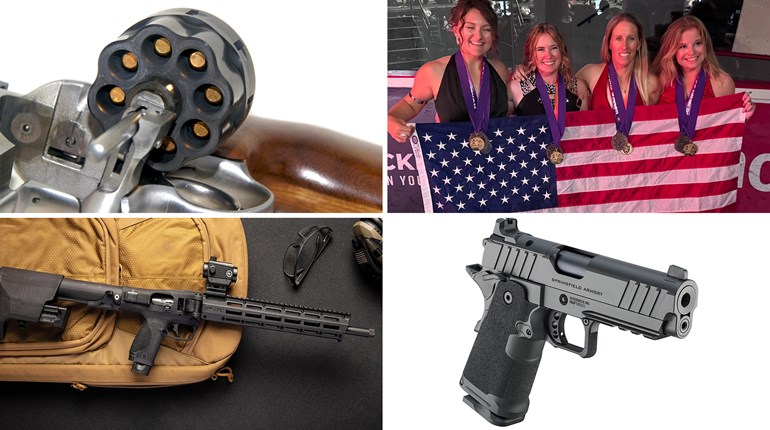
We old guys knew that before and after the Army switched to 9 mm in the mid-1980s. And the handgun most closely associated with the .45 ACP is the Colt M1911, despite numerous other semi-automatic manufacturers chambering their beefed-up 9 mm handguns for the battle-proven .45 ACP. We old guys knew that back when all those companies were just building 9 mms. In the handgun world, it seems young guys have spent the last few decades rediscovering what old guys already knew. If that statement infuriates you young guys, let me throw a little more fuel on the fire.
Back in World War I (which I did not personally attend), the U.S. Army began sending a lot of the then-new M1911s to Europe for our doughboys to use in the fray. Unfortunately, it was sending a lot more guys than it had 1911s, so a solution was needed to give our boys a suitable handgun. For multiple reasons, it was agreed the caliber should be .45 ACP. Clearly, the answer was a revolver, and at the time, both Colt and Smith & Wesson were making some fine large-frame revolvers chambered in the classic 19th century .45 Colt. Cartridge size was not an issue in getting a revolver to handle the .45 ACP; rather it was the rimless case and how to make the .45 ACP work with revolver extractors designed for rimmed cartridges. The answer was as simple as the half-moon clips that held three rounds each and creating enough space between the rear of the cylinder and the breech face to accommodate the half-moon clips. Add some manufacturing schedule changes at the two major handgun producers and voila, Johnny marched off to the Western Front with a first-class handgun. Some young guys of that era worried the revolvers would be inadequate for the task, but even then, old guys knew better.

I didn't have access to any Great War surplus revolvers, but I was able to get my hands on a couple of Smith & Wessons from the company's Classics revolver line: specifically a pair of Model 22s in .45 ACP. A review of the "Standard Catalog of Smith & Wesson" by Jim Supica and Richard Nahas revealed the new Model 22 with a 5.5-inch barrel is a good alternative to the Model 1917 the company made during the Great War to fill in for 1911s. At least it was a good substitute in those categories affecting how it performed in the hands of a shooter. Sights are fixed, with the rear being a square notch cut into the topstrap and a round, .1-inch wide front blade. In my opinion, these sights are considerably better than the tiny V-notch rear and skinny blade on military 1911s. And like the original M1917 revolvers, the newer Model 22 has a capacity of six rounds, but it can be loaded in a greater variety of ways—two, three-round half-moon clips, one, six-round full-moon clip or six individual .45 ACP cartridges. Without the clips, each round of ammunition head-spaced on a square cut shoulder inside the chamber.
Also, like the original M1917, the new gun has a lanyard ring at the base of the grip and a non-shrouded ejector rod. Differences include a pinned barrel on the original M1917, smooth versus checkered grip panels on the new gun, nicer bluing on the modern gun and of course, the much-maligned keyhole safety in the side of the frame just above the cylinder-release latch on new Smith & Wessons. I consider these differences more cosmetic than functional, with no bearing on performance.
In a head-to-head comparison with the original M1911, the M1917 fairs quite well. As mentioned, the revolver's sights are better than the original GI semi-auto. Capacity of the two guns is very close; seven rounds in old Slabsides versus six in the wheelgun. I'm using seven rather than eight rounds for capacity of the 1911 because doctrine of the day dictated the semi-auto be carried with a loaded magazine in the gun, but hammer down on an empty chamber. Upon drawing, the soldier had to rack the slide in order to chamber the first round. I consider this a big advantage for the revolver, with its simple "pull, point, shoot" manual of arms. If you talk to newer shooters today, you'll find the simplicity of getting a gun into action makes double-action revolvers the choice for many. Even in the post-frontier days of the early 20th century, many young men going into the Army were unfamiliar with handguns, making them essentially equivalent to the new shooters of today. Those who had some handgun experience probably obtained it with revolvers—another point for the M1917.
With regard to reloading speed, I have to go with the 1911, although the use of half-moon clips certainly helps close the gap. Actually the reload might favor the semi-auto more than one might think. I recall seeing GI magazine pouches for the 1911, but nothing comparable for carrying half-moon clips. Ammo performance is a toss-up more dependent on an individual gun than on a categorical difference between semi-automatics and revolvers. In this case, you have a 5-inch barreled 1911 (which isn't all barrel because it includes the cartridge chamber) versus a 5.5-inch barreled revolver with an extra inch or so of chamber plus a pressure leak called the barrel/cylinder gap. No point quibbling over what the difference might be when the bullet comes out.
The final and most important comparison is the performance when actually shooting either firearm. I can't presume to give a conclusive answer here, but there are a couple of considerations I would mention. Even after World War II, there were many more negative comments than favorable ones from veterans about the 1911. Granted, this is anecdotal rather than scientific evidence, and many World War II veterans never really worked with a revolver. But the truth is, through the mid-20th century, America was still basically revolver oriented. Other than collectors and a few bullseye shooters who were learning that a well-tuned 1911 was a superbly accurate handgun with clear shooting advantages, civilians and police alike were all about revolvers. Modern training curricula and techniques have clearly showed us the semi-auto's advantages. Even Jerry Miculek, arguably the greatest revolver shooter ever, has acknowledged semi-autos have a definite speed edge over a revolver. This doesn't mean the revolver's day is done. It is still a useful and formidable handgun just as it was in World War I, when it went to war side-by-side with the 1911. Ask new shooters who have looked at both revolvers and semi-autos and chosen a revolver rather than listening to all the hype. Many young guys (and gals) still prefer the old reliable wheelgun. But then, we old guys could have told you that.




































